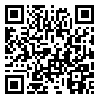Volume 15, Issue 4 (Winter 2008)
JSSU 2008, 15(4): 3-8 |
Back to browse issues page
Download citation:
BibTeX | RIS | EndNote | Medlars | ProCite | Reference Manager | RefWorks
Send citation to:



BibTeX | RIS | EndNote | Medlars | ProCite | Reference Manager | RefWorks
Send citation to:
Golestan M, Fatemi A, Bahrami-Ahmadi A. Study of the Corelation between Transcutaneous Bilirubin Levels (Jh 20-1 Bilirubinometer) and Serum Bilirubin Levels (Laboratory). JSSU 2008; 15 (4) :3-8
URL: http://jssu.ssu.ac.ir/article-1-614-en.html
URL: http://jssu.ssu.ac.ir/article-1-614-en.html
Abstract: (14848 Views)
Introduction: Hyperbilirubinemia is a common benign problem in neonates. Nonetheless, if untreated, severe hyperbilirubinemia is potentially neurotoxic. The standard method for diagnosis of hyperbilirubinemia is determination of serum bilirubin levels in the laboratory that requires a blood sample which is both painful and stressful for neonates and entails cost and time.
The objective of this study was to study the correlation between transcutaneous bilirubin levels (JH 20-1 bilirobinometer) and serum bilirubin levels.
Method: This prospective study was done on 100 jaundiced newborn term infants from March to October, 2006. Initial clinical assessment of jaundice was carried out by a physician (researcher) and simultaneously, blood sample was collected and a JH20-1 bilirubinometer was applied at two sites forehead and sternum.
Results: The study group consisted of 57 boys and 43 girls diagnosed as jaundiced neonates. The mean serum bilirubin and mean transcutaneous bilirubin levels at forehead and sternum were 13.35, 12.95 and 12.46 mg/dl, respectively.
The correlation coefficient of bilirubin levels estimated by the bilirubinometer at the forehead and sternum and serum levels were 0.773 and 0.731, respectively. At bilirubin levels higher than 12 mg/dl (cut off point), the bilirubinometer had a decreased sensitivity, but an increased specificity.
Conclusion: Transcutaneous bilirubin measurements using JH20-1 bilirubinimeter correlate well with total serum bilirubin levels, but when bilirubin levels are higher than 12mg/dl, sensitivity of the device is reduced and therefore not reliable.
| Rights and permissions | |
 |
This work is licensed under a Creative Commons Attribution-NonCommercial 4.0 International License. |





